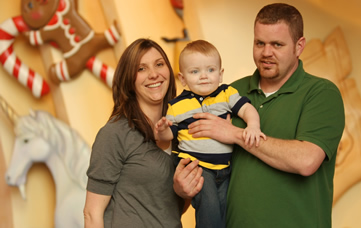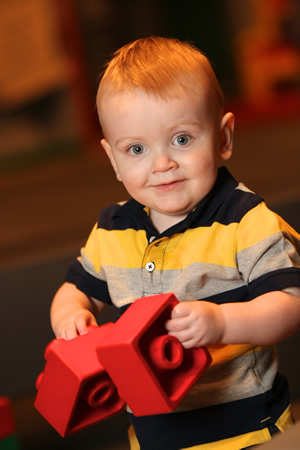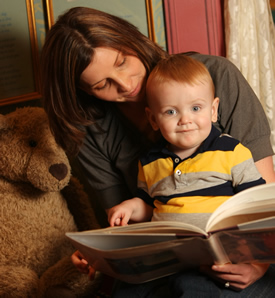Miracle Kids: Owen Harford
With Specialized Care a Little Fighter Gets a Strong Future
 April and Nick Harford didn’t think too much about the newborn screening tests they did at the beginning of their pregnancy during the Summer of 2008. It was just a matter of routine. But when their Ithaca obstetrician told them the test showed their baby had a chance of having spina bifida, it no longer felt routine.
April and Nick Harford didn’t think too much about the newborn screening tests they did at the beginning of their pregnancy during the Summer of 2008. It was just a matter of routine. But when their Ithaca obstetrician told them the test showed their baby had a chance of having spina bifida, it no longer felt routine.
The Harfords, who live in Brooktondale near Ithaca, made an appointment with a perinatologist in Elmira. The week-long wait for the appointment was excruciating for April so she begged her obstetrician to do an ultrasound in the meantime. Thankfully, the spine looked normal. Unfortunately, the abdomen did not.
The specialist in Elmira confirmed that the Harford’s baby had gastroschisis, a congenital defect of the abdominal wall in which the belly doesn’t close all the way, allowing the intestines and, sometimes, other organs to form outside the body. The defect occurs in about 1 in 5,000 to 1 in 10,000 babies.
“I was devastated. It was our first baby,” April said. “Defects are something you think about but you never think it’s going to happen to your baby.”
The defect was very apparent even to April’s and Nick’s untrained eyes – big loops of intestines floating around inside the amniotic fluid. The specialist said the baby, which they now knew was a boy, seemed to also have a dilated bowel. They were worried about obstructions developing somewhere in those loops, so the Harfords would need to come back every other week for monitoring.
After a few visits, the three-dimensional ultrasounds started to feel routine. April even went by herself, but at her 32-week check, she brought her sister so she could see her nephew’s face.
“They put the monitor on me and started looking. Then the nurse stopped and said she needed to get the doctor,” April said. “I knew something was wrong.”
The baby had developed a new complication – a large, unidentifiable bubble on his bowel. They weren’t sure if it was his bladder, another organ or something else entirely. They wanted to deliver the baby immediately, but Nick wasn’t there and April didn’t feel ready. She was worried the baby wasn’t far enough along.
The specialist called Golisano Children’s Hospital at the University of Rochester Medical Center (URMC) for a second opinion. Walter Pegoli, M.D., chief of pediatric surgery, said April should see a perinatologist at URMC before making any decisions.
April and Nick drove to Rochester that afternoon, petrified they were going to deliver their baby boy the next morning. Daniel Grace, M.D., the high-risk obstetrician who saw them when they arrived, reassured them. The baby just needed some additional monitoring to make sure he was doing OK and growing larger. The planned caesarean section in December needed to be at URMC, where all the right specialists were available.
 April thought she might’ve just been a little dehydrated when she started feeling sick at about 7:30 p.m. Nov. 25. She was almost 36 weeks along. They had an appointment to meet Pegoli the next morning and she hadn’t yet toured the neonatal intensive care unit (NICU). She called her obstetrician who told her to lay down and see how she felt. When the crampy feeling didn’t go away by 12:30 a.m., she and Nick started driving to Rochester.
April thought she might’ve just been a little dehydrated when she started feeling sick at about 7:30 p.m. Nov. 25. She was almost 36 weeks along. They had an appointment to meet Pegoli the next morning and she hadn’t yet toured the neonatal intensive care unit (NICU). She called her obstetrician who told her to lay down and see how she felt. When the crampy feeling didn’t go away by 12:30 a.m., she and Nick started driving to Rochester.
An hour or so into the drive, a police officer pulled them over for speeding. Nick barely got the story out of his mouth when the officer told them to get on their way.
“Just drive as safe as you possibly can,” April remembered him saying. She said he must have known how nervous they were.
The couple arrived at URMC at about 2 a.m., and it didn’t take long for the obstetrical team to see that April was in labor and already 5 centimeters dilated. The baby was OK but he was coming. They tried to slow down her labor while they called Pegoli in to prepare to perform surgery on the soon-to-be-born baby boy.
Owen Harford arrived at 5:21 a.m. by caesarean section and he was immediately whisked off to surgery. Nick caught a glimpse of Owen in the hallway, but April didn’t get to see or hold her new baby. The Harfords waited nervously for news about their son. April’s cell phone rang. It was Pegoli’s office, calling to cancel their consultation with the pediatric surgeon that morning because he had an emergency surgery. “That was me! We’re here!” April told the scheduler. It was a brief moment of levity for the Harfords.
Meanwhile, Pegoli was in the operating room marveling at the sheer amount of bowel outside Owen’s tiny belly.
“There was more bowel than baby,” Pegoli said.
Usually, when faced with gastroschisis, Pegoli uses a manufactured plastic device called a silo to hold the bowels over the baby’s belly until there is room enough for them in the abdomen.
“His defect was so big that we had no off-the-shelf silo to use,” Pegoli said. “So I built one.”
When Pegoli came to see the Harfords after the initial surgery, April asked what the bubble was on Owen’s bowel. Pegoli said it was just a cyst and wasn’t anything serious, but what was more concerning was the sheer amount of bowel Owen had outside his body. He said he wasn’t sure it would all fit into his tiny abdomen. But Owen was ready to meet his parents.
April was worried about her baby and still groggy from the anesthesia when Nick wheeled her into the NICU to see Owen for the first time. She was overcome but, on the eve of Thanksgiving, she was also thankful for her brand new baby and wondered if the cyst appeared for a reason.
“We knew that we were supposed to be there… If we were going to be anywhere and give our son a chance for survival, we knew we were in the right hospital.”
April and Nick had done a lot of research on the surgery Owen would undergo, but seeing his bowel in, essentially, a plastic bag suspended over his belly was difficult. Over the next week, Pegoli’s team, including Heather Goetzman, P.N.P., worked to push Owen’s bowels into his tiny abdomen. When the last of it fit, it was time to close his belly, but there wasn’t enough skin and muscle to cover the defect’s hole.
 Pegoli placed an absorbable mesh over the hole and put a special dressing over it to encourage natural tissue to grow. Once that tissue grew enough, Owen underwent another surgery to place a skin graft over his abdomen. It would be a temporary fix because all that was between Owen’s bowels and the world was a very thin piece of skin. But after 100 days in the NICU, on March 5, Owen finally went home.
Pegoli placed an absorbable mesh over the hole and put a special dressing over it to encourage natural tissue to grow. Once that tissue grew enough, Owen underwent another surgery to place a skin graft over his abdomen. It would be a temporary fix because all that was between Owen’s bowels and the world was a very thin piece of skin. But after 100 days in the NICU, on March 5, Owen finally went home.
April and Nick worked hard to give Owen as much normalcy as possible at home, knowing that he’d need more surgery very soon. In June, he came back to Golisano Children’s Hospital for surgery with John Girotto, M.D., a pediatric plastic surgeon. Girotto’s aim was to stretch Owen’s belly skin enough to remove the skin graft and close the defect with thicker skin. That meant placing two tissue expanders, essentially expandable balloons, into either side of his belly.
“Tissue expanders require a lot of attention and work. We modified our surgery so that Mom and Dad could perform some of that daily work while at home,” Girotto said. “They became an important part of our team. Nothing fazed them at all.”
April and Nick, with the help of Christine Emerson, P.N.P., gradually filled the balloons with saline, stretching his skin over time. The expanders were cumbersome for the active boy as he grew more mobile and they grew bigger. April had a comically hard time getting his clothes to fit, and he had a bout with an infection around one of the expanders. But he fought off the infection and the expanders worked. On Sept. 17, Girotto removed the expanders and stitched Owen’s belly shut. He was finally whole.
“He has a large scar, but from what it looked like before to what it looks like now, it’s beautiful,” April said. “It’s just beautiful.”
Today, Owen is a happy, active toddler, who not only walks, but runs at a surprising clip. He has hit his developmental milestones with gusto like the tiny hero he is.